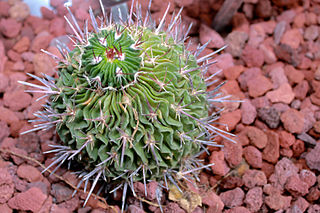
Thelocactus is a genus of flowering plants in the cactus family Cactaceae. Members of the genus are native to the arid lands of Central and Northern Mexico.

Kroenleinia grusonii, popularly known as the golden barrel cactus, golden ball, "mother-in-law's cushion" or "mother-in-law’s chair", is a species of barrel cactus which is endemic to east-central Mexico.

Astrophytum capricorne, the goat's horn cactus, is a species of flowering plant in the cactus family Cactaceae, that is native to the Coahuila regions of Northern Mexico. Growing to 50 centimetres (20 in) tall by 10 centimetres (3.9 in) wide in a ball or oval shape, it is grey-green in colour with 7 to 9 prominent ribs, very long twisted spines and yellow flowers with a red centre in summer.

Ariocarpus agavoides is a species of cactus. It is endemic to Mexico. It grows in dry shrubland in rocky calcareous substrates. Some taxonomists place it in a separate genus as Neogomezia agavoides. The locals use the slime from the roots of the plants as glue to repair pottery. The sweet-tasting warts are eaten and often added to salads

Rapicactus zaragosae, synonym Turbinicarpus zaragosae, is a species of plant in the family Cactaceae. It is endemic to Mexico. Its natural habitat is hot deserts. It is threatened by habitat destruction.

Echinocereus chisoensis is a rare North American species of cactus known by the common name Chisos Mountain hedgehog cactus.

Cochemiea conoidea, common name Texas cone cactus or Chihuahuan beehive, is a species of cactus native to southern United States to central Mexico.

Stenocactus multicostatus, the brain cactus, is a member of the cactus family native to the deserts of Mexico, and is popular in the gardening community. It has gained the Royal Horticultural Society's Award of Garden Merit.

Thelocactus rinconensis, synonyms including Thelocactus nidulans, is a species of cactus. It is endemic to north-east Mexico.

Thelocactus tulensis is a species of cactus. It is endemic to Mexico.

Thelocactus bicolor, the glory of Texas, is a species of flowering plant in the cactus family, widely distributed in the northern Chihuahuan Desert of Texas and Mexico.

Ferocactus chrysacanthus, commonly known as the Cedros barrel cactus, is an endangered species of cactus endemic to the islands of Cedros and West San Benito off the Pacific coast of Baja California, Mexico.

Lobivia ancistrophora is a species of cactus. It has a globular shape, few spines, with large, white flowers attached to long, green tubes. It occurs in Bolivia, at altitudes of 600–1800 metres. Under its synonym Echinopsis ancistrophora it has gained the Royal Horticultural Society's Award of Garden Merit.

Pelecyphora aselliformis is a species of Pelecyphora found in Mexico.

Pelecyphora robbinsiorum known by the common names Cochise pincushion cactus and Cochise foxtail cactus is a species of flowering plant in the family Cactaceae.

Echinocereus primolanatus is a species of cactus native to Mexico.

Echinocereus stolonifer is a species of cactus native to Mexico.

Echinocereus bristolii is a species of cactus native to Mexico.
Thelocactus multicephalus, is a species of cactus endemic to Nuevo León, Mexico.
Thelocactus buekii is a species of cactus. It is endemic to Mexico.


















